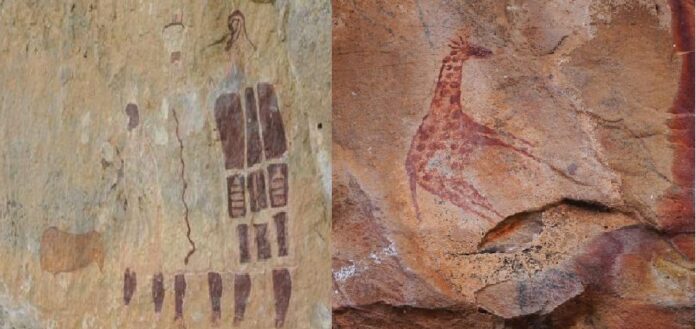San rock art is or maybe the most popular of all of Africa’s stone arts, and it is likewise among the most surely known.
For a pretty long time, analysts accepted that the art was just a record of day-to-day existence or a crude type of hunting enchantment.
Those were the times of look and surmise, when it appeared to be that the more one looked at the art, the better one’s conjecture would be concerning its importance. Fortunately, those days are no more.
By connecting explicit San convictions, recorded in recorded meetings with San sources, to repetitive highlights in the art, scientists have had the option to ‘figure out the code’ of San rock art.
It uncovers one of the most minds boggling and modern of the multitude of the world’s symbolic arts.
From a general perspective on life, the art centers around a particular part of San experience: the soul world excursions and encounters of San ceremonial trained professionals or shamans.
Subsequently, we see many elements from the exceptionally significant daze dance, the scene wherein the shamans accessed the soul world. Africans performed the daze dance for a long time.
The men would move, following each other in roundabout examples, while the ladies would applaud and sing the melodies of the various creatures.
During this dance, they would call upon the strength or power of significant soul creatures.
The artists would feel their energy, known as n|om, bubbling in their stomachs before shooting out the rear of their necks. At this, the artists would enter the soul world.
In this world, the healers might search the downpour creature, which they would slice to make a downpour.
They may likewise fight with the pernicious spirits of the dead who cause disorder in the living.
Ceremonial experts may likewise intercede with the spirits of game creatures to cause them to act pleasantly with the goal for trackers to get them.
Various typical dance stances are as often as possible portrayed in the artworks:
- Twisting forward at the midsection (at times upheld by moving sticks)
- Having the arms held out in reverse
- Draining from the nose and the connected hand-to-nose act
Moreover, the artists frequently painted certain things explicitly connected with the dance. Most dance clatters and fly-whisks regularly.
These pictures all relate the works of art to the daze dance, incorporating artists tumbling down in a daze, after which they experience dreams of the soul world.
A large part of the symbolism goes past the actual dance.
It portrays the encounters and activities of shamans in the soul world, for example, dreams of the previously mentioned downpour creatures and spirits of the dead.
A considerable lot of the creatures met within the soul world are portrayed in rock art.
We also see pictures of artists with eland hooves and heads showing that they have taken on gazelle power, similar to what San shamans depict in the Kalahari today.
Then, at that point, we see shamans scaling the purported ‘strings of light’ that interface with the sky-world.
We see daze flight, as it portrays individuals with padded limbs and their arms back like wings.
The artists likewise utilized visual allegories to show their encounters, for example, showing shamans ‘submerged’ encompassed by fish and ‘dead,’ penetrated with numerous bolts.
These catch parts of how it feels to be in a daze.
Yet, the art was not just a record of soul ventures. Unique substances, for example, eland blood, were placed into the paints to make each picture a supply of strength.
As every generation of artists painted or engraved an endless supply of art on the stone surfaces, they made powerful, profound spots.
Later, guests could draw on this strength to the site, the two artists and artists.
We are lucky to have this insight concerning the artistic creations since it gives significant bits of knowledge into the existences of individuals living before.
Lamentably, it is hard to tell how old the more significant part of the works of art is: the dating of rock artworks is a standing issue the world over.
The issue is just that there is very little, assuming any, natural material in the shade that can be dated.
Most shades are mineral in the beginning (red, brown, and yellow colors) are produced using ochres of different structures, while they produce the white from silica, china mud, and gypsum.
Natural folios, for example, blood and egg whites, were in some cases utilized in the paint and flow research is investigating the dating of these substances.
Staff at RARI has likewise embraced examination to date the dark shade in artworks, prominently in the Maclear locale of the Eastern Cape.
Late discoveries from this space recommend that a portion of the compositions are no less than 3000 years of age.
Rock etchings, or petroglyphs, are found in the inside level of Southern Africa.
In contrast to canvases found in caverns and rock covers, inscriptions happen on rough outcrops (ordinarily of dolerite or diabase), in some cases in rough riverbeds, or just on rocks in the level veld.
The artists removed the dim, endured external skin (or patina) to uncover the paler stone underneath during the etching system.
They utilized three procedures to eliminate the stone patina: entry point (lines cut with a sharp stone), pecking (pounding and chipping), and scratching.
The engraved surfaces climate over the long run and procure a similar dull color as the first surface.
Regardless of the likenesses, there are clear contrasts among inscriptions and canvases.
In the descriptions, creatures are more normal than human figures, yet they portray fewer species than in the compositions.
Although numerous huge stones or rock surfaces with many inscriptions, we frequently find rocks with a solitary mathematical shape or single creature.


